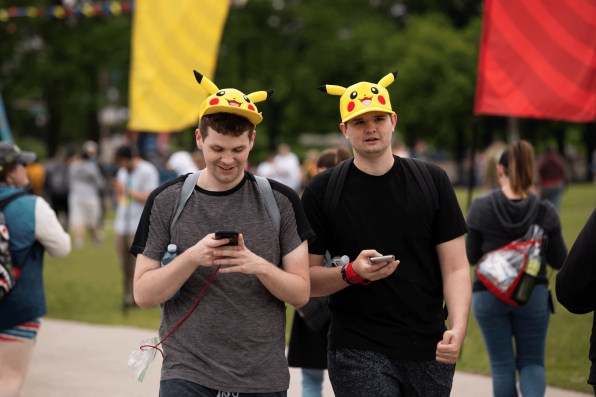‘Pokémon Go’ turns five: Why AR’s defining game is bigger than ever
Tuesday marks the fifth anniversary of the launch of Pokémon Go, the video game that brought players out of their homes and changed the way people think about augmented reality.
While Pokémon Go was the subject of sensational news coverage and viral jokes when it launched on July 6, 2016, it continued to be successful even after it stopped being the meme of the moment. In fact, Google spinoff Niantic—the company behind the game—says that last year was its biggest year in terms of revenue so far, despite the pandemic.
Niantic tweaked the game, which normally requires players to go to particular locations to catch Pokémon and pit them in battle against rivals, to allow more at-home play. But as virus-related restrictions ease in the United States, the company is planning a hybrid in-person and at-home Pokémon Go festival for the weekend of July 17—and seeing a resurgence of players going out to Pokémon gyms and other locations that the smartphone game overlays on real-world places.
“People are eager to get out and reconnect in the world and get back to their favorite park, their favorite burger joint, the place where they used to get together with their Pokémon Go friends,” CEO John Hanke says.

Though Niantic doesn’t release financial numbers, Sensor Tower estimated that Pokémon Go hit$3.6 billion in total revenue by its fourth anniversary. Hanke tells Fast Company that the business is “really healthy,” with Pokémon proceeds reinvested in at least 10 upcoming augmented reality projects. Those include a Pikmin game—like Pokémon Go, in partnership with Nintendo using characters from one of its video game franchises—as well as a Transformers game and one tied to the strategy board game Settlers of Catan. There’s also a collaboration in the works with Punchdrunk, the theater company best known for its immersive, Macbeth-inspired experience Sleep No More.
“We’re really taking this idea of transforming the world into this arcade of entertainment experiences that you can have while you’re out of the house and walking around and doing stuff with your friends—taking that as far as we can,” Hanke says.
The Pokémon Go game has evolved over time to be more of a social experience, says Hanke, adding features like raid battles, where groups of people get together at physical locations to battle powerful monsters, Pokémon trading, player-versus-player Pokémon battles, and group snapshots.
“Every year we’ve had at least one feature that’s really caught everyone’s attention,” Hanke says.
He attributes the game’s continued popularity—stats the company does share include 28 billion kilometers walked by players and 422 billion Pokémon caught—compared to other AR experiences, which have largely been a flash in the pan, to the fact that it brings people out of their homes to experience something they can’t enjoy any other way. Like many software companies, Niantic tracks the amount of time people spend playing its games and whether they return to play again, but the company also keeps tabs on stats such as how much time people walk while playing and the extent to which they explore new places.
The upcoming Transformers game will feature enhanced AR technology further integrating it into the world, letting multiple players in the same location see the same giant robots overlaid on the landscape from different perspectives.
“The holy grail for AR is a shared experience and a persistent experience,” Hanke says, saying the company is also working on making AR game elements more persistent, with an eye towards 2022 releases.

He says the full potential of AR technology, which he sees as the next big way people will interact with computing devices, hasn’t yet been reached. But he anticipates video games will lead the way toward making the technology mainstream. The company worked with Microsoft on a proof-of-concept Pokémon Go demo for Microsoft’s HoloLens AR platform.
Niantic also prides itself on the diversity of players who enjoy Pokémon Go, including a large number of women and people aged at least into their 30s and 40s. Hanke imagines the upcoming games will each attract their own audiences, with the Catan game more focused on long-term strategic thinking and the Transformers experience more built around live, instantaneous combat that might appeal to a traditional gaming audience.
The upcoming Pokémon Go Fest will have a music festival theme, and it will allow people to meet up in parks in 20 cities around the world or continue to play from home if they feel more comfortable doing so. But as the world recovers from the coronavirus pandemic, Hanke says he anticipates players returning to old Pokémon hunting haunts and visiting new places.
“People have been cooped up for 12 months, 15 months, and it’s really explosive in terms of people’s desire to get back out,” he says.
(47)



